Salesforce and Outlook are two indispensable applications used by multiple businesses nowadays. However, with the upcoming retirement of the Salesforce Outlook plugin, you need to make a decision on what solution your team will be using instead of the native connector.
We have analyzed the available Outlook integrations with Salesforce and created this guide with a detailed comparison of choices available to replace Salesforce’s retired Outlook Connector.
Salesforce Outlook Plugin: the Basics
Salesforce for Outlook is a Salesforce-native application that creates a simple data connector between Salesforce and Microsoft Outlook email, calendar, tasks, and contacts. The integration automatically updates Salesforce with customer data captured in Outlook and makes that data available to streamline internal communication, enhance customer relationships, and close transactions.
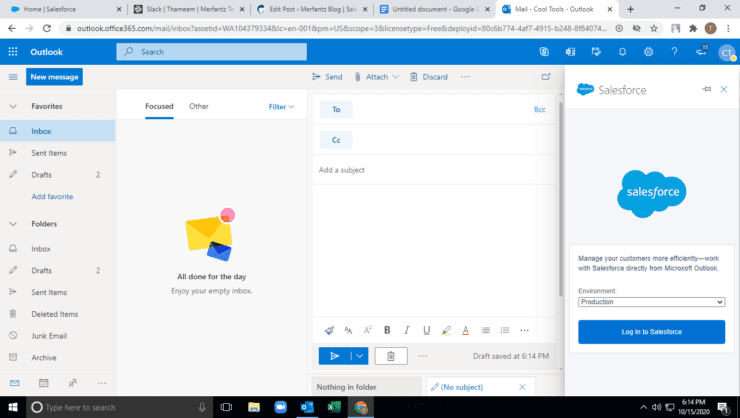
Benefits of connecting Outlook and Salesforce
- Work with Salesforce data directly in Outlook inbox
- Create Salesforce records from Outlook
- Easily log emails and events from Outlook to Salesforce
For businesses using both Salesforce and Microsoft Office, the Salesforce Outlook plugin has offered a means to bridge the data gap between the two applications. With Salesforce for Outlook, contacts, events, and tasks are automatically synced, eliminating the need to manually port customer data from one application to the other. Once captured, Outlook Salesforce plugin makes messages, events, and contacts visible in the Salesforce Activity Timeline to provide customer-specific context for use by all authorized team members.
Why is Salesforce for Outlook being retired?
In the simplest possible terms, Salesforce Outlook plugin is aging out.
Salesforce add in for Outlook was initially developed to connect Salesforce Classic and pre-Internet Explorer 11 (IE11) versions of Outlook. With the advent of IE11, however, which communicates via APEX calls, Salesforce for Outlook—which naturally doesn’t—was made reliant on Lightning Experience to interpret IE11’s APEX calls.
While the use of Lightning Experience satisfied the need for a technical workaround to the APEX call discontinuity between Salesforce Classic and IE11, it was always intended as a stopgap measure. Most customers have switched to Lightning, and Salesforce continues to refine its Microsoft Integration products. So, Salesforce is phasing out its support of Outlook for Salesforce integration now, in preparation for its retirement, now rescheduled from June of 2023 to December of 2027.
The Retirement Timeline of Salesforce for Outlook
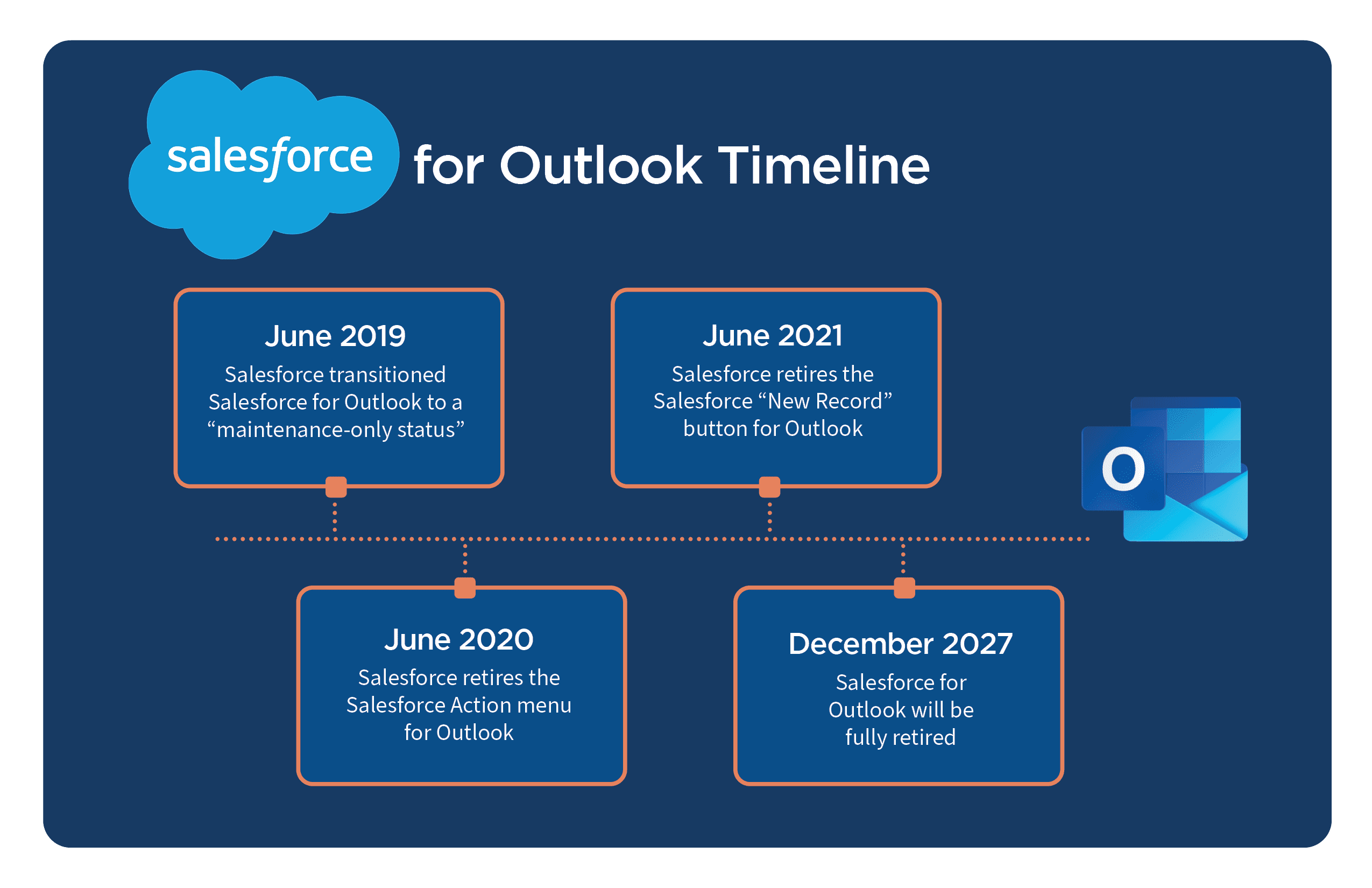
In June of 2019, Salesforce transitioned Salesforce for Outlook to “maintenance only status,” which limited its availability to existing users only. This step marked the beginning of Salesforce’s phased retirement of the Salesforce for Outlook plugin. June of 2020 marked the next step in this phased retirement process, as Salesforce retired the Salesforce Outlook plugin Action Menu, which let users create new Salesforce records from the side panel in Outlook. Since that date, users no longer had access to the “New Records” button, eliminating their ability to create Salesforce records from Outlook through the Salesforce plugin for Outlook application.
In December of 2027 (originally June of 2023), if everything goes according to plan, Salesforce will officially retire Outlook Salesforce plugin. At that time, administrators will lose access to all remaining Salesforce Outlook addin features —and all settings and user assignments saved in Outlook configurations. Fortunately, the app’s retirement won’t impact saved contact, event, task, or email data, which will remain available in their existing Salesforce and Outlook formats.
To learn Salesforce’s perspective on the retirement of Salesforce plugin for Outlook, the following publications offer further details:
- Salesforce for Outlook is Retiring: Salesforce to Outlook plugin has been helping reps stay productive for a long time. But between June 2021 and December 2027, Salesforce Outlook connector is retiring in a phased approach. Learn about retirement details and your options for Outlook integration with Salesforce after retirement.
- Outlook plugin for Salesforce no longer connects for some customers working from Lightning Experience.
Is There Life After Salesforce For Outlook?
As luck would have it, Salesforce for Outlook isn’t the only data integration game in town. Third-party developers (including Riva team) have created a range of options to accomplish—and in specific use cases outperform—Outlook plugin for Salesforce as a tool for sharing vital customer data between Salesforce and Outlook email, calendar, tasks, and contacts.
From a performance perspective, each solution carries its own list of pros and cons. In most cases, those differences are reflected in the cost and capabilities of each solution. Some solutions are better suited for the data integration needs of small companies, some are a better fit for mid-sized companies, and still, others are ideal for use by large, highly-regulated enterprises with industry-specific data security, privacy, and compliance concerns—and larger revenue data ops objectives.
While the retirement of Salesforce Outlook add in is an inconvenient reality for many, it also presents an opportunity to re-evaluate your organization’s needs and to seek the solution best positioned to meet them.
Factors to consider when choosing a new Salesforce Outlook plugin:
- Budget – how important is reliable customer data integration—or, in many cases, revenue data ops— and how much is your organization prepared to allocate for it?
- Scale – how big is your organization, and what are the volumes and types of data you need to unify, govern, and distribute to internal and customer-facing teams?
- Security – what level of communication and revenue data security is your organization required to provide?
- Compliance – is your organization in a regulated industry subject to compliance requirements? If so, what are the reputational and financial ramifications of non-compliance?
- Configurability – are your organization’s needs well served by a simple, plug-and-play data integration solution, or do you have specific governance needs that require advanced configurations and developer support?
- Support – will your organization require proactive, around the clock critical response support, or will a robust knowledge base suffice?
Top 5 Salesforce-to-Outlook integration recommendations
In most cases, the size of your organization is a good, albeit generic metric to assess your options. For comparison purposes, we’ve assembled this top 5 Salesforce-to-Outlook rev ops solution guide based on enterprise size, as indicated below:
| Large enterprises | Mid-sized businesses | Small and startup businesses |
| Riva | Einstein Activity Capture | Zapier |
| LinkPoint 360 | Cirrus Insight |
As companies face the retirement of Salesforce for Outlook, there’s no better time to do an in-depth evaluation of your organization’s customer data integration needs. Download the Riva Enterprise Evaluation Guide – and get a head start on finding the right solution for your organization.
Riva – the most flexible enterprise relationship and sales engagement platform
Riva has created the leading solution for enterprise-level Outlook integration with Salesforce, offering the ability to securely unify, govern, and distribute data—while ensuring regulatory compliance and building data trust.
Thanks to AI-powered Revenue Data Ops Engine—which unifies data siloed in CRM, email, calendar, contacts, and communication platforms like Teams, Zoom, and Slack—Riva governs the data distribution to both internal and customer-facing end-users. For Salesforce and Outlook users, this ensures that end-users have comprehensive, real-time access to customer histories, which help to build strong, long-term customer relationships—and optimize customer lifetime value.

CRM ↔ Address Book
- Contacts / Persons
- Accounts
- Leads
- Contact Notes
- Custom Fields

CRM ↔ Calendar
- Appointments
- Meetings
- Recurring Events
- Custom Categories
- Resource Calendars
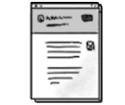
CRM ↔ Email
- CRM Contacts
- Accounts
- Opportunities
- Cases
- Contracts
- Custom Objects

CRM ↔ Tasks
- SalesForce
- Calendars
- Inboxes

CRM > Folders/HTML Email
- Opportunities
- Cases
- Contracts
- Custom Objects to Mail Folders
Designed to scale and sync in real-time, Riva’s pass-through architecture supports 150,000 simultaneous users and more than 5 million calendar appointments per month. The Revenue Data Ops Engine ensures the application of enterprise-specific rules to create secure, private, and compliant data flows between Salesforce and Outlook email, calendar, task, and contact applications – whether deployed on-site or in the cloud.
Interested in a deeper dive? Read this to learn more about how Riva can replace – and dramatically improve upon – Salesforce Outlook plugin.
Features
- Designed for enterprise-scale
Riva provides support for upwards of 150,000 simultaneous users, and more than 5 million calendar appointments per month.
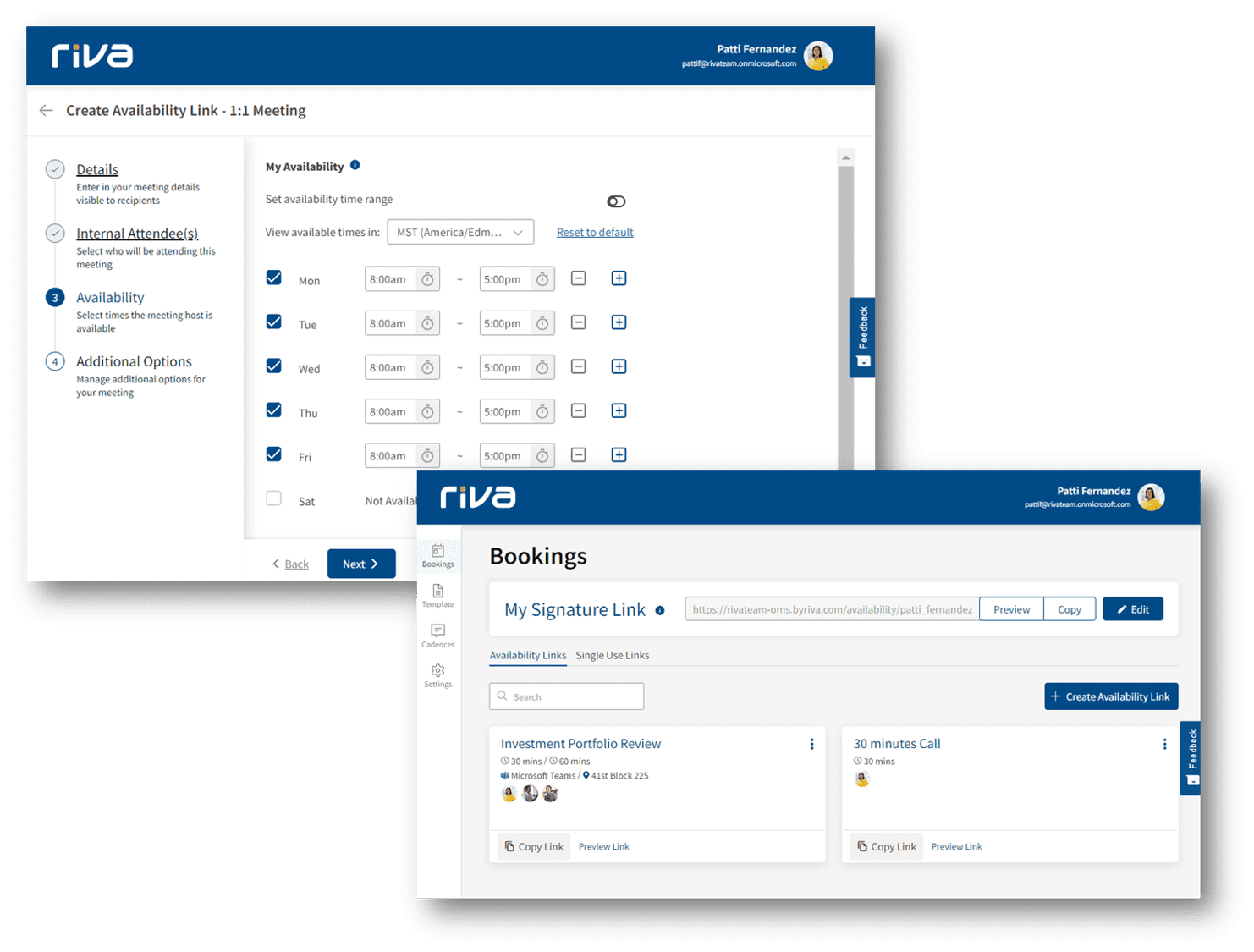
- Improved productivity
With seamless Outlook and Salesforce integration, Riva helps you get more out of your CRM with integrated AI-powered data curation, meeting scheduling, and sales engagement capabilities while having your sales teams work where they want to – within their email client and their mobile devices.
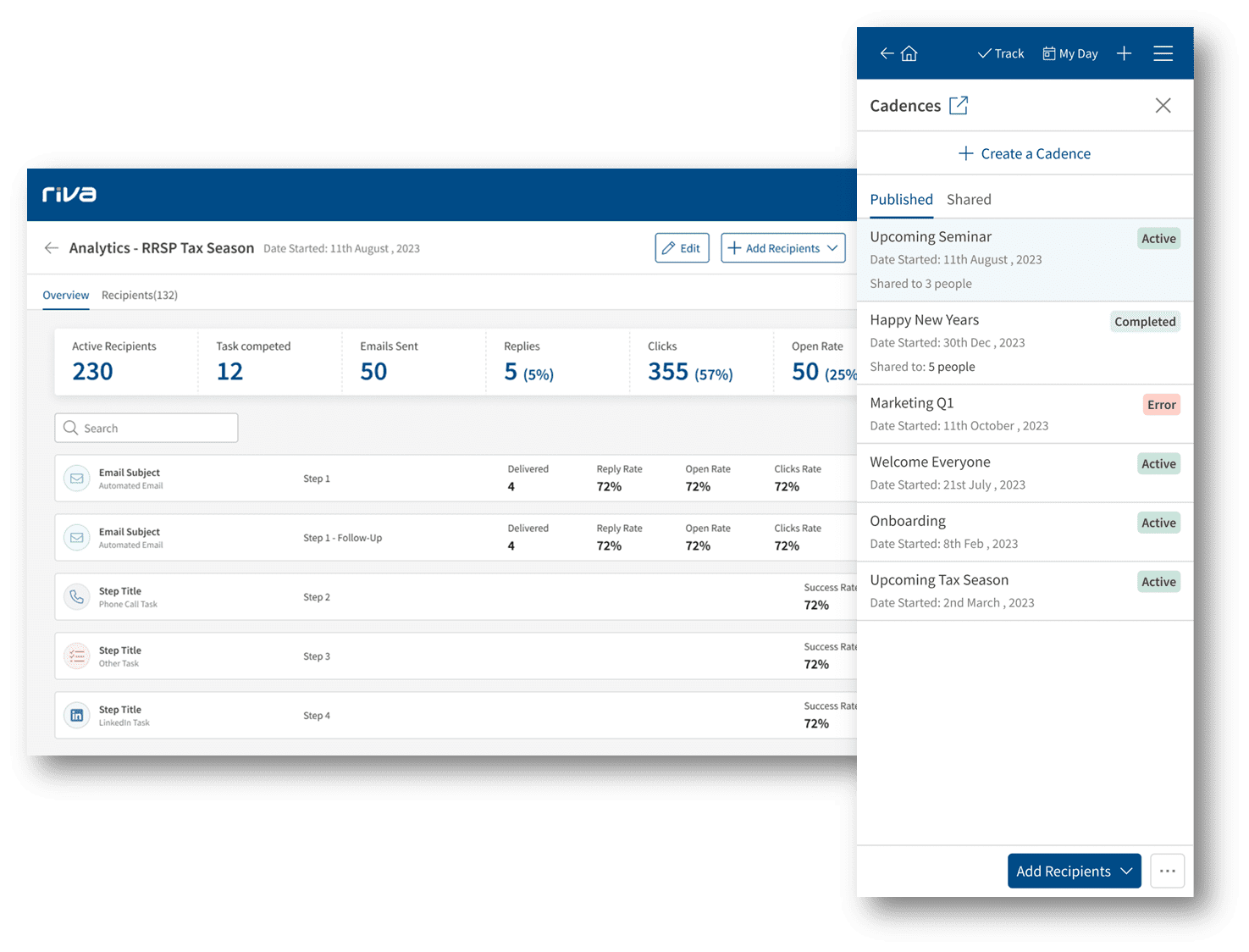
- Regulations compliance
Riva monitors regional, national, and global regulations that govern the use of customer data in financial, healthcare, and governmental industries to ensure client compliance and avoid financial sanctions and reputation damage. Riva is trusted by the leading financial institutions.
Related customer story: One of America’s Big Four Banks Relies On Riva to Build Relationships, Protect Customer Privacy, and Maintain Their Reputation - Security guaranteed: The only connector that has earned SOC2 attestation
Riva earns and maintains a long list of third-party data security certifications that reflect an unyielding commitment to regional, global, and industry-specific security requirements.
Related customer story: This Top Investment Bank Is Smarter and More Secure with Riva Sync
- Create records, log Outlook events and calls to Salesforce
As the only enterprise-level data integration solution to offer real-time data sync, Riva ensures access to up-to-the-minute information for team members throughout the enterprise, helping to improve customer service, prevent relationship missteps, and avoid missed sales opportunities.
Related customer story: Pernod Ricard Uses Riva to Sync Salesforce, Office 365, and iPad in Real-Time
- Access Salesforce data from Outlook
Riva Insight bridges Salesforce and Exchange/Outlook by surfacing and allowing your staff to enhance and secure data in real-time—right inside their inbox or calendars. With Riva, relevant, conditioned, and curated data (including data from custom fields) is always available via a seamless data flow between applications, eliminating the need for task switching and data entry duplication.
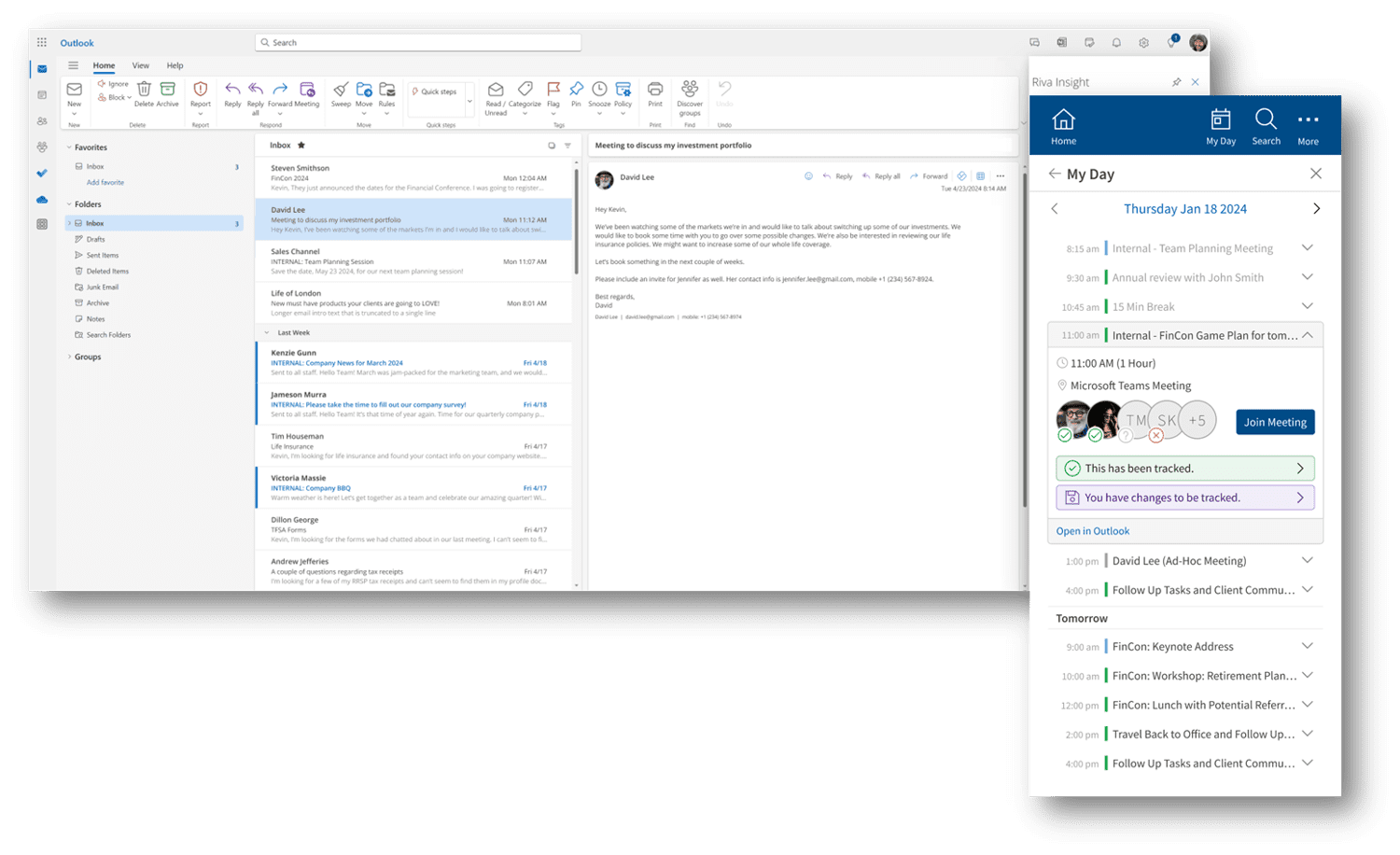
- Set up access to Salesforce records to ensure MNPI compliance
End-users can extend our advanced, granular privacy and security settings for the sharing of material non-public information (MNPI) right through our side panel.
Benefits for Business Teams
- Relationship truth
Riva syncs and surfaces data between Microsoft/Outlook and Salesforce to deliver Customer360 overview, build data trust, and bolster end-user and customer confidence. - Low Friction Digital Selling
Data embedded in an advisor’s preferred workflow (whether Outlook/Exchange or Salesforce) provides critical context and saves time. - Data Driven Decision Making with Customer 360
With a true Customer360, you get dashboards and KPIs fueled by signals—not noise, to ensure end-users have real-time access to customer details most relevant to their needs. - Improved customer experiences
Riva Engage provides your customer-facing teams with all the tools they need to deliver quality customer interactions and navigate complex customer journeys from within Outlook.
Benefits for Technology Teams
- Reduced Security Risk
Riva has achieved SOC2 attestation, and our pass-through architecture ensures that your data remains secure—whether in the cloud or in your data center. - Reduced Customizations
Riva maps key data models and flows so your applications just work—without any build on your part. We are highly configurable so we can meet the exact specifications of our customers in regulated industries. - Reduced Project Risk
Our data operations team specializes in connecting these two platforms in some of the most complex enterprise environments in the world. Riva can safeguard your project to deliver value to the business on time and on budget.
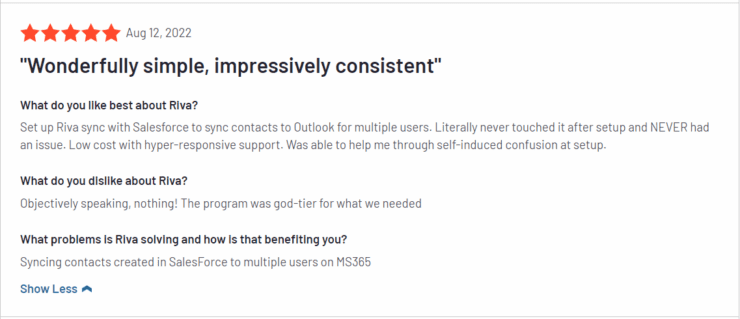
Limitations
Due to the sophistication of its solutions and its capacity for customization, Riva is not ideally suited for smaller teams or organizations.
Pricing
- Sales Engagement Essentials (Starting at $25 user/month)
Get started with seller workflow automation with sales engagement capabilities including email bursts & templates, email opens & clicks, and enterprise meeting scheduling. - Sales Engagement Professional (Starting at $45 user/month)
Take your seller workflow automation to the next level with everything in “Essentials” and added features including cadences, sharing & delegation, and Riva copilot Al assistant. - Activity Capture Professional (Starting at $45 user/month)
Maximize customer 360 relationship data with calendar integration, meeting and email activity capture, contact & and lead integration, Insight Outlook side panel, calendar availability, meeting booking link, and Riva copilot Al assistant. - Riva for Enterprise (pricing based on customization)
Individually customized to serve the unique needs of your organization, Riva for Enterprise begins with collaboration, where we engage with your stakeholders, then configure a solution that unifies and curates your communication and revenue data, and gives you unmatched power to ensure it’s serving the best interests of your organization—and your customers.
Best For
Mid- to large-sized enterprises, particularly those in industries like finance, insurance, pharmaceuticals, healthcare, and government, with elevated data security and regulatory compliance burden.
Book a meeting here if you’re interested in learning more about Riva and which pricing bundle best serves your needs.
Einstein Activity Capture*
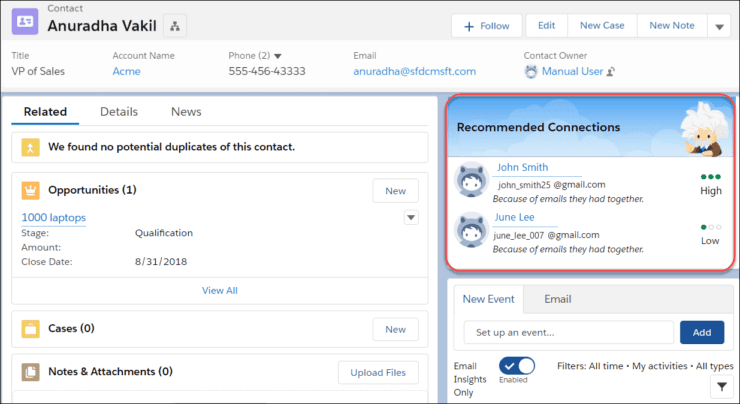
This Salesforce-native solution serves the data integration needs of small- and mid-sized businesses.
With Salesforce for Outlook on its way out, Salesforce is promoting Einstein Activity Capture as the heir apparent. To bridge the gap between Salesforce and Outlook emails, calendar events, tasks and contacts, Einstein Activity Capture adds new Outlook data to corresponding records in Salesforce, thus eliminating the need for your organization’s team members to manually enter customer information in both platforms. Captured messages and events are then visible in the Salesforce Activity Timeline, where they provide key customer context for the entire team.
Once the data conduit between applications is established, Salesforce’s Sales Cloud Einstein analyzes the data stream, applies machine learning algorithms, and produces Einstein Opportunity and Account Insights to provide team members with relevant information – and guide them toward appropriate action.
For administrators and managers, Einstein Activity Capture provides reporting on team member activities. These insights can then be used to identify patterns, and to replicate best practices throughout the organization.
Once active, the free version of Einstein Activity Capture maintains logs of the past 6 months (24 months for paid) of historical Outlook data , capturing all emails, and calendar events sent or received during that timeframe in the cloud. These captured events are displayed in the Activity Timeline to provide a moving two-year history of the team’s relationship with each customer – associating all Outlook records with Salesforce Leads, Contacts, Accounts, Person Accounts, and Opportunities.
Features
- Automatic Email and Calendar Sync captures every email, meeting, contact, and task created in Office 365 and shares that data with Salesforce
- Activity Reporting provides data-driven opportunities to coach and incentivize team members with activity leaderboards
- Fast & Easy Setup of a native application, allowing easy connection and sync with Outlook data
- Sharing Settings allows users to define who can see emails and events, ensuring customer data privacy
- Built-in Controls enable administrators to adjust sharing settings and control access to sensitive data
- Administrators can identify and blacklist specific domains and email addresses to prevent the collection and sharing of messages from and to sensitive sources
Benefits
- Einstein Activity Capture is included in all Salesforce products. As a native Salesforce application, its use avoids the time and costs necessary for a third party data integration solution
- Einstein Activity Capture provides administrators with comprehensive activity data to provide abundant team member coaching opportunities
- Eliminates the need for manual data logging – and reduces the risk of missed connections and opportunities
Limitations
- Not optimized for industry-specific compliance (e.g.: MNPI)
- Does not work with Financial Services Cloud Interactions Module
- Stores captured data for Active Directory/Exchange in AWS by default—allowing Salesforce users to view and manage ungoverned data across all users in the entire email system
- Storage and display are limited to 24 months of captured activity data for Office 365 users and held in the cloud
- If an organization deactivates Einstein Activity Capture, its captured activities will no longer be available in Salesforce record timelines
- Does not support deployment in on-premises data centers or private cloud
Pricing
- Standard: no fee for Salesforce users, but access to key features is limited or restricted
- Paid Subscription: $50 per user per month when bundled with Sales Cloud Einstein
Best For
Startups and mid-sized businesses not subject to industry-specific regulatory compliance or worried about security issues in the cloud
Recommended reading: How Riva Sync and Einstein Activity Capture Stack Up
Cirrus Insight*
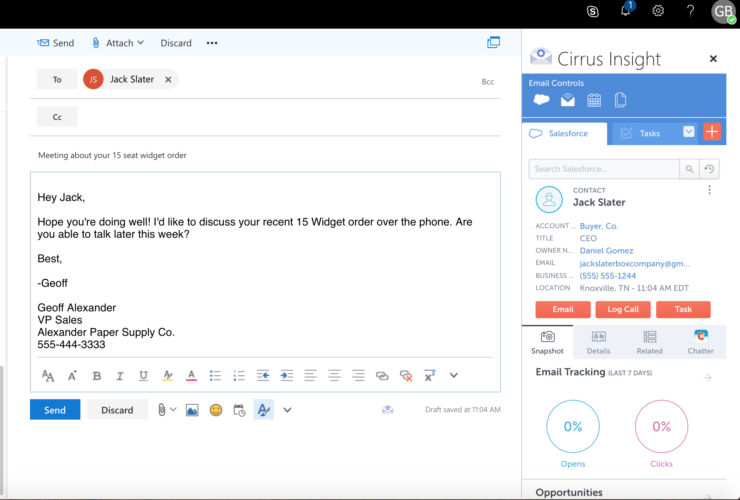
Cirrus Insight is a third-party data integration solution designed to Outlook integration with Salesforce, which includes share data between Salesforce and the Outlook email, calendar, tasks, and contacts applications your team members use to communicate—both internally and externally—every day. Once implemented, Cirrus Insight can track email and attachment opens, create personalized email templates, send email drip campaigns, set follow-up reminders, and schedule more meetings with customers.
Cirrus Insight’s Salesforce.api also offers a range of integrations that leverage the link between Salesforce and Outlook, effectively eliminating the need to manually enter data captured in one application to the other. This seamless connection provides team members with a more comprehensive picture of each customer’s historical interactions with your organization – helping to save time, improve customer satisfaction, avoid missed opportunities, and make sales efforts more efficient and effective.
Once implemented in your organization, Cirrus Insights automatically syncs Outlook emails and calendar appointments to Salesforce, tracks email opens, and sets follow-up reminders. Cirrus can also create and update Salesforce records such as leads, contacts, and opportunities – and can be used to schedule sales calls.
Features
- Simple, effective CRM-to-Outlook integration (Salesforce)
- Automatically logs Outlook emails, calendar events, and tasks in Salesforce
- Syncs Outlook contacts to Salesforce, simplifying team-wide access to prospects and accounts
- Supports automated email sequences and follow-ups
- Allows tracking and notification of email opens, clicks, and engagement – directly in SFDC
Benefits
- Easy installation requires limited IT support
- Keeps team members informed and updated of all customer interactions, helping to leverage shared knowledge, improve customer satisfaction, and close transactions
- Avoids missed opportunities resulting from the inefficiencies of manual data input to update Salesforce with Outlook data, and vice versa
Limitations
- Meaningful integration requires time, persistence, and fine tuning
- No ability to create custom data flows
Pricing
- Salesforce Sync: starting at $10/user/month
- Pro: starting at $21/user/month
- Expert: starting at $29/user/month
- Additional features are available, with additional monthly per-user fees
Best For
- Small businesses/Startups
- Mid-sized businesses not subject to industry-specific regulatory compliance (e.g.: Material, non-public information)
Recommended reading: How Riva and Cirrus Insight Stack Up
LinkPoint360*
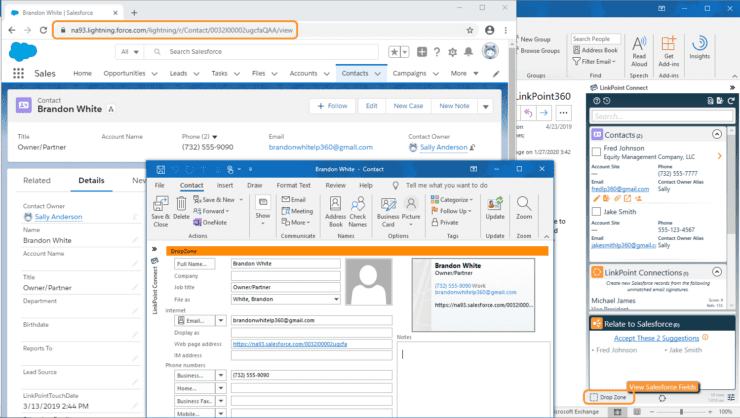
Like its competitive counterparts, LinkPoint360 is a third-party solution designed to connect leading CRMs – including Salesforce – with the email, calendar, task, and contact applications its clients use. A capable alternative to Outlook plugin for Salesforce, LinkPoint Connect eliminates the need for duplicate data entry by enabling its users to view, create, and update Salesforce data within the screen context of their Outlook email.
Features
- Provides accurate reporting of email openings
- LinkPoint Connections is a built-in contact assistant that allows users to select which emails to easily select and share specified contacts with Salesforce
- Integrated security protocols prevent CRM and server data compromise
- Dedicated customer service team ensures smooth onboarding, training, and organizational adoption
- Single-click email recording allows for easy email integration by both administrators and end users
- Designed for custom Salesforce object and field detection
- Optional email sync eliminates the need for manual designation of which emails to share with Salesforce
Benefits
- Secure client-side deployment simplifies implementation and protects sensitive data from compromise
- Ability to track email openings assists in the measurement of campaign conversion and helps to determine appropriate follow-up
Limitations
- To optimize performance, LinkPoint360 can require IT support and fine-tuning
- For organizations that require customized data integration options, LinkPoint360 native functions may not provide adequate utility and flexibility
Pricing
Outlook Integration (Salesforce): $16 per user/month
Best For
Mid-sized businesses not subject to industry-specific regulatory compliance (e.g.: SOC2)
Recommended reading: How Riva and LinkPoint360 Stack Up
Zapier*
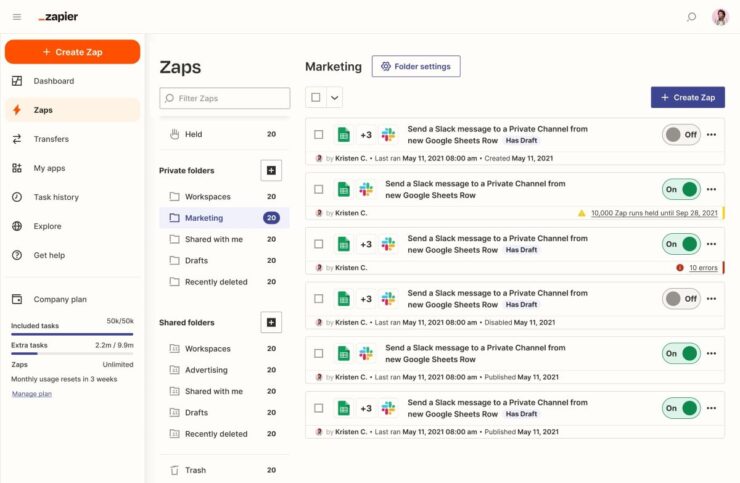
Zapier – plug and play data integration for small business.
Zapier is a web-based tool that forms data connections between disparate third-party applications, allowing for the automation of repetitive tasks that would otherwise require users to transfer data manually. Designed for plug-and-play, Zapier shares data between Salesforce and Microsoft Outlook without the need for custom coding by developers.
Zapier shares data in workflows called “Zaps,” which connect apps to automate repetitive tasks. Once a user sets up a Zap, Zapier monitors the app for the defined event. Each occurrence of the event in the app signals a “Trigger” to complete the defined action. Zapier pricing is based on Trigger volume, on the frequency of updates between designated apps, and the range of capabilities available for use.
While its capabilities are somewhat limited, Zapier provides small businesses and startups with an economical alternative to Salesforce to Outlook plugin.
Zapier provides users with a range of Salesforce/Outlook data integration actions, including:
- Outlook calendar event starts
- New and updated Outlook calendar events
- New Outlook contacts
- New Outlook emails
- Highlighting when new outbound messages are received in Salesforce
- Finding Salesforce records
- Adding Salesforce contacts to campaigns
- Adding Salesforce Leads to campaigns
- Creating Salesforce attachments
- Creating, updating, and finding Salesforce records
Features:
- Bank-level encryption to ensure data security
- Easy, plug-and-play integration
- Multi-app compatibility
Limitations:
- Zapier does not provide industry-specific regulatory compliance support
- Zapier offers a range of built-in apps that simplify workflows between a range of apps. These apps provide many use case options, but they are not designed for nuanced, organization-specific customization.
Pricing:
Zapier offers free plans and trials that limit the number of tasks a user can attempt in a short period
Pricing levels range from $19.99/user/month to $899.99/company/month (billed monthly). Lower prices limit the number of “Zaps” within a given timeframe and the number of tasks per month (tasks exceeding monthly allocations are charged per use). Zaps are also synced based on package pricing – with lower-priced options syncing every 15 minutes and top-priced options syncing every minute.
Best For:
Zapier is best used by companies with 10-50 employees, and $1-10 million in revenue
Summary
With Salesforce Outlook plugin being retired, many users need to make a decision on what connector to use. We have reviewed the main Salesforce Outlook connectors, and hope that our guide will help you make an informed decision and choose the tool best suited for your business challenges.
Riva Salesforce Outlook integration is a reliable solution that will help you access Salesforce data right from Outlook, and ensure seamless bi-directional sync. Riva solution has been helping many businesses like yours to save multiple hours’ worth of work, at the same time providing exceptional user experience.
Book a meeting if you’re interested in learning more about the Riva engine and which pricing bundle best serves your needs.
*Trademarks, product and trade names, logos, images, and brands that appear on our website are the property of their respective owners and are used for identification purposes only. Their use does not imply or suggest affiliation, sponsorship, endorsement, partnership, or approval by their respective owner.
Recent articles
- Guide to Einstein Activity Capture: All You Need to Know
- 2024 Bankers Summit: 5 Key Takeaways
- Financial Services: Mastering Customer 360 and Client Engagement for Increased Customer Lifetime Value
- Dreaming Big at Salesforce Education Summit San Diego 2024
- How to Build a Sales Cadence in 2024: Examples and Best Practices
